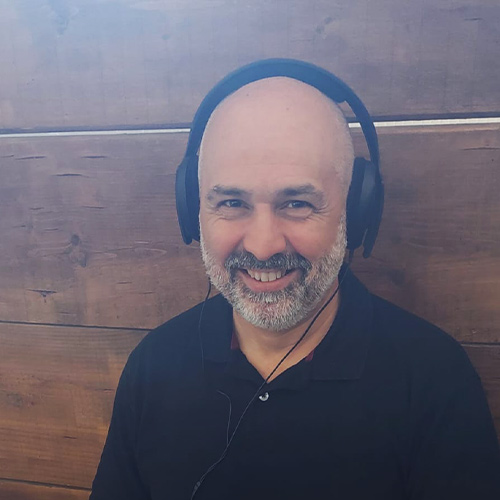

The bunker in the Garden of arches
The bunker in the Garden of arches
Riproduci traccia audio
Play audio track
Audio-Track abspielen
The bunker in the Garden of arches
Trascrizione traccia audio
The first time I noticed the bunker I was stationed nearby in an ambulance. It was winter, it was bitterly cold and there was a thick thick fog.
I am not originally from Cesenatico, I came here 30 years ago for work reasons, and for the last 19 years I have been a Red Cross volunteer. Joining a voluntary organisation for me was the way to reciprocate the warmth with which I was welcomed by the town.
Something irregular immediately struck me about this concrete block: the door. The front door faces the sea. It is as if the danger was coming from the land and the sea, the infinite expanse of water, had to be protected.
I imagined a German soldier sent here, far from home to a place not his own. During his watch he probably had to be on his own, at the tender age of twenty managing the responsibility of defending the area assigned to him. But the darkness, the sounds of the sea and the silence of the town amplify the thoughts, and the darkest thoughts and fears start to emerge.
Who knows how many tears that soldier shed? I imagine him waiting, waiting for them to give him the command to enable him to down his weapons at the end of his watch, exchange a few words with a comrade and get some rest, because tomorrow he will have to face another long, uncertain day at his lookout post again.
Tobruk, this type of bunker is called a Tobruk, a structure designed by the Italians in North Africa during the Second World War. Initially it was nothing more than an iron container immersed in the ground or the sand, with an opening at the top where one soldier with a machine gun was stationed.
It was the Allies who chose this name for the bunker, inspired by the Libyan port where it was used for the first time. The Germans improved its structure and used it on several war fronts, including Italy.
In Cesenatico there are several, like this one, built in concrete and reinforced with steel. You can barely move in this cramped and lightless interior, icy in winter and stuffy in summer.
It is not the place itself that struck me, but what was inside; a place that has endured sacrifice and a lot of solitude.
Now there is life flowing around, but there is no memory of this bunker. Now people pass by unaware, maybe someone leans against the concrete block to tie their shoes, only the children go curiously up to the glass of the entrance, from where you can still see that cramped interior.
Try, try to look inside, even for a single moment, just to remember.
Audio Track transcription
The first time I noticed the bunker I was stationed nearby in an ambulance. It was winter, it was bitterly cold and there was a thick thick fog.
I am not originally from Cesenatico, I came here 30 years ago for work reasons, and for the last 19 years I have been a Red Cross volunteer. Joining a voluntary organisation for me was the way to reciprocate the warmth with which I was welcomed by the town.
Something irregular immediately struck me about this concrete block: the door. The front door faces the sea. It is as if the danger was coming from the land and the sea, the infinite expanse of water, had to be protected.
I imagined a German soldier sent here, far from home to a place not his own. During his watch he probably had to be on his own, at the tender age of twenty managing the responsibility of defending the area assigned to him. But the darkness, the sounds of the sea and the silence of the town amplify the thoughts, and the darkest thoughts and fears start to emerge.
Who knows how many tears that soldier shed? I imagine him waiting, waiting for them to give him the command to enable him to down his weapons at the end of his watch, exchange a few words with a comrade and get some rest, because tomorrow he will have to face another long, uncertain day at his lookout post again.
Tobruk, this type of bunker is called a Tobruk, a structure designed by the Italians in North Africa during the Second World War. Initially it was nothing more than an iron container immersed in the ground or the sand, with an opening at the top where one soldier with a machine gun was stationed.
It was the Allies who chose this name for the bunker, inspired by the Libyan port where it was used for the first time. The Germans improved its structure and used it on several war fronts, including Italy.
In Cesenatico there are several, like this one, built in concrete and reinforced with steel. You can barely move in this cramped and lightless interior, icy in winter and stuffy in summer.
It is not the place itself that struck me, but what was inside; a place that has endured sacrifice and a lot of solitude.
Now there is life flowing around, but there is no memory of this bunker. Now people pass by unaware, maybe someone leans against the concrete block to tie their shoes, only the children go curiously up to the glass of the entrance, from where you can still see that cramped interior.
Try, try to look inside, even for a single moment, just to remember.
Audiotrack-Text
The first time I noticed the bunker I was stationed nearby in an ambulance. It was winter, it was bitterly cold and there was a thick thick fog.
I am not originally from Cesenatico, I came here 30 years ago for work reasons, and for the last 19 years I have been a Red Cross volunteer. Joining a voluntary organisation for me was the way to reciprocate the warmth with which I was welcomed by the town.
Something irregular immediately struck me about this concrete block: the door. The front door faces the sea. It is as if the danger was coming from the land and the sea, the infinite expanse of water, had to be protected.
I imagined a German soldier sent here, far from home to a place not his own. During his watch he probably had to be on his own, at the tender age of twenty managing the responsibility of defending the area assigned to him. But the darkness, the sounds of the sea and the silence of the town amplify the thoughts, and the darkest thoughts and fears start to emerge.
Who knows how many tears that soldier shed? I imagine him waiting, waiting for them to give him the command to enable him to down his weapons at the end of his watch, exchange a few words with a comrade and get some rest, because tomorrow he will have to face another long, uncertain day at his lookout post again.
Tobruk, this type of bunker is called a Tobruk, a structure designed by the Italians in North Africa during the Second World War. Initially it was nothing more than an iron container immersed in the ground or the sand, with an opening at the top where one soldier with a machine gun was stationed.
It was the Allies who chose this name for the bunker, inspired by the Libyan port where it was used for the first time. The Germans improved its structure and used it on several war fronts, including Italy.
In Cesenatico there are several, like this one, built in concrete and reinforced with steel. You can barely move in this cramped and lightless interior, icy in winter and stuffy in summer.
It is not the place itself that struck me, but what was inside; a place that has endured sacrifice and a lot of solitude.
Now there is life flowing around, but there is no memory of this bunker. Now people pass by unaware, maybe someone leans against the concrete block to tie their shoes, only the children go curiously up to the glass of the entrance, from where you can still see that cramped interior.
Try, try to look inside, even for a single moment, just to remember.
Narrato da
Narrated by
Mehr Infos



